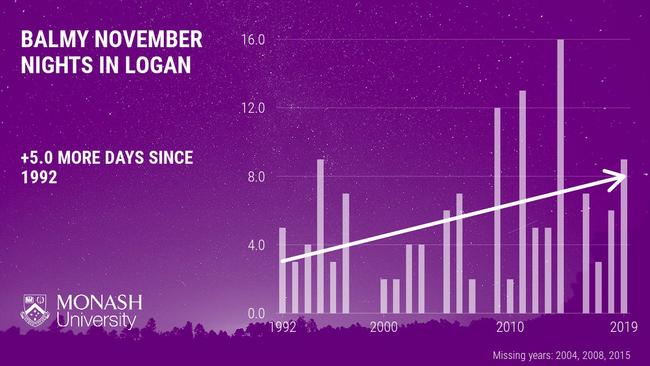Weather bureau latest: scorching temperatures forecast for this year's Brisbane Blast.
Dr Christa Pudmenzky discusses Logan's forecast and warming night temperatures. Plus insights from Boronia Heights resident Lisa Maloney on local wildlife and bushland.

HyperLocal
Don't miss out on the headlines from HyperLocal. Followed categories will be added to My News.
Logan is forecast for more clouds this weekend, with temperatures warming up on Sunday hitting a top of 33 degrees for this year's Brisbane Blast.
The sun might be hiding, but UV ratings are still high so be sure to slip slop slap.
Daytime temperatures are not the only things heating up this time of year.
Compared to the 1990s, Logan averages five more November nights reaching at least 20 degrees.
Back in 1992 there were five balmy nights in November reaching at least 20 degrees, but last year there were nine.
The year that recorded the most warm November nights was 2014, with 16 nights of the month reaching 20 degrees.
Scientists say the average number of these warm nights has increased significantly, which is consistent with warming trends across southeast Queensland.
Did you know?
Across the world, nights are warming faster than days.
This shows that rising temperatures are not caused by changes in sun activity.
If warming was caused by an increase in the Sun's energy, we would see a faster rise in daytime temperatures, rather than night-time temperatures.
Warmer nights can affect the quality of our sleep, making it harder to fall asleep and stay asleep when temperatures are higher.
Voices from your community
Lisa Maloney has lived in Boronia Heights for 25 years and believed that local wildlife and bushland has changed.
"Dry spells last longer and are more frequent," she said.
"Birdlife has changed, there are fewer wrens and other smaller species.
"Scrubby Creek has become dry and the bushland has much less ground cover than 20 years ago."
Community voices like Lisa's tell us how residents and business owners in Brisbane feel about their local climate. If you would like to contribute your voice to our column, you can fill out our 5-minute survey here.
Dr Christa Pudmenzky is a climate scientist at the University of Southern Queensland.
This column is part of a collaboration between Monash University and News Corp to deliver hyperlocal weather and climate information.
Questions? You can email us at mcccrh@monash.edu
